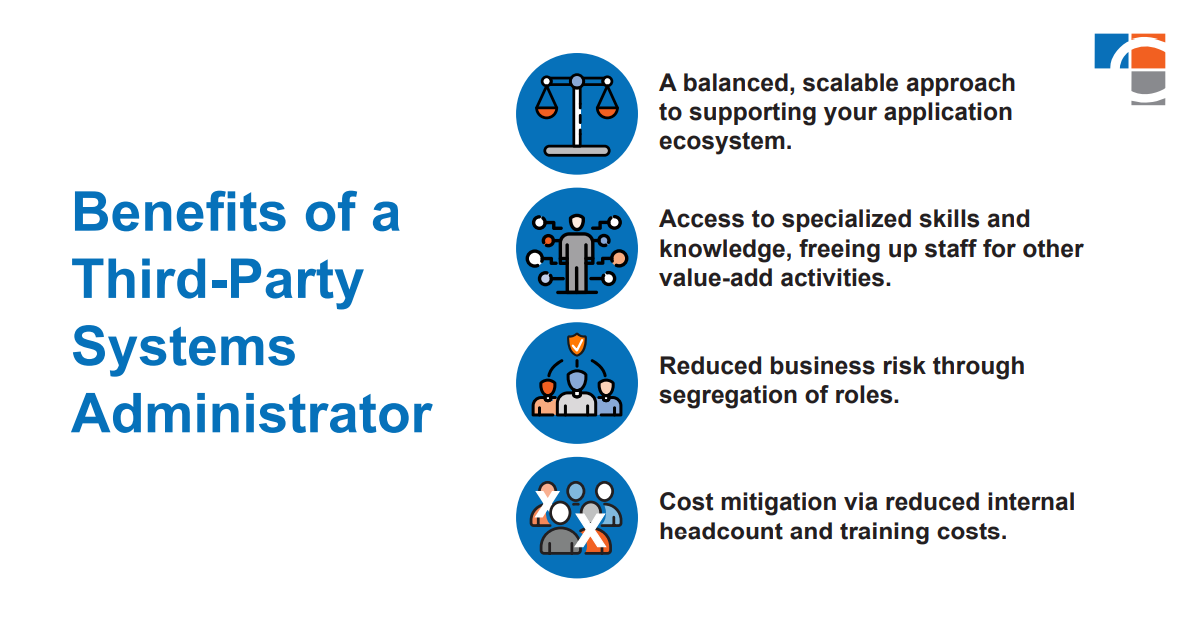You just implemented your SaaS enterprise application you were told needed only minimal support.
Because it’s – allegedly – a light lift (and cheaper), your organization opts to appoint as system administrator a member of staff who has availability to “help,” just not the proper, ongoing skills to do so.
Even if this administrator was heavily involved in the initial implementation and will be a power user, it won’t be long until you recognize that go-live is just the beginning of the application’s journey. Its actual value and impact on your organization start now – but you’re missing the critical infrastructure to realize true ROI.
Can You Rely on a Part-Time Systems Administrator?
Applications consistently roll out new features and updates throughout the year, and your organization is most likely evolving with growth or change. Maintaining alignment between systems, processes, and roles over time is the key to maximizing ROI.
The chief barrier, however, is that your administrator has another day job, which leads to multiple debilitating issues that introduce risk across the rest of the business, such as:
- Inflexibility when demand surges: When questions or issues arise during a surge period, it’s incredibly difficult for a single part-time administrator to keep up.
- Continuous training to maintain comprehensive knowledge: SaaS enterprise applications like Coupa or Sage Intacct are constantly evolving and rolling out new features. This requires a level of dedication to continuous learning. Ongoing system training is not going to be a priority when your administrator has competing operational activities they need to complete.
- Overall organizational risk: No one likes the phrase “but let’s think about segregation of duties.” There may be situations in which your accounts payable manager is also an admin in a system where they can manage suppliers, approve or bypass invoices, and maybe even execute payments.
- High turnover risk: Isolated or limited knowledge of the system within the organization can create significant gaps/risks if those key individuals leave. Additionally, there is a scarcity of talent with the right experience and skills, so the time to hire a candidate requires more time and money.

Benefits of a Third-Party Administrator
Rather than settle for an in-house, part-time administrator, your organization may opt to have a full-time administrator dedicated solely to your application ecosystem. This is a considerably necessary and effective evolution in the application journey – if done well.
The issue is that the skill set and technical agility required to support the application still reside in one individual, which is a risk in its own right. Further, inefficiencies that exist in a part-time model often still appear in a full-time model.
That’s why top-performing companies with robust digital ecosystems leverage third parties for more balance during demand cycles. Third parties enable organizations to achieve the “gold standard” support model, which includes:
- A balanced, scalable approach to supporting your applications with relevant expertise. Additionally, a provider that brings a holistic view to your technology stack can support continuous innovation and optimization throughout every piece of connected systems architecture, creating real integration between IT and other business units.
- Access to specialized skills and knowledge to keep their applications up to date and closely aligned with evolving business needs. This allows your internal resources to focus on core business activities that drive value, not on IT support tickets.
- Reduced overall risk by being able to segregate roles and reduce the complete loss of system knowledge when turnover hits.
- Mitigating costs directly by leveraging third parties to reduce internal headcount and training costs. Indirectly, not keeping your enterprise applications aligned with your evolving business will inherently have a large opportunity cost.

While a part-time or full-time systems administrator is a valuable asset, they’re not the type of on-demand, high-ROI partner that’s needed in the long run.
Distinguishing Between a Third Party and a True Partner
Not just any third-party support will do. You’re looking for a true value-add.
A good partner will:
- Help resolve tickets while strategically getting to know your business for additional support capacity.
- Make recommendations based on the experience of companies similar to yours.
- Help you mitigate costs and maximize investment by leveraging the full power of applications across multiple lines of business.
To better understand the value of an implementation partner and how we can support your enterprise application journey, contact CrossCountry Consulting today.